In this article, you will learn exactly what is SEO lead generation, why is it so important, and how to get SEO leads using my 7-step proven process.
The SEO lead generation process will walk you through how to find important and relevant keywords for your products and services, build topic authority in your industry and rank your important profitable or money keywords in order to start generating leads day and night.
What is SEO Lead Generation?
SEO lead generation is a process of attracting organic visitors to your websites from search engines like Google or Bing by targeting the right SEO keywords, that bring users that are searching for your products or services or could be potentially interested in the future.
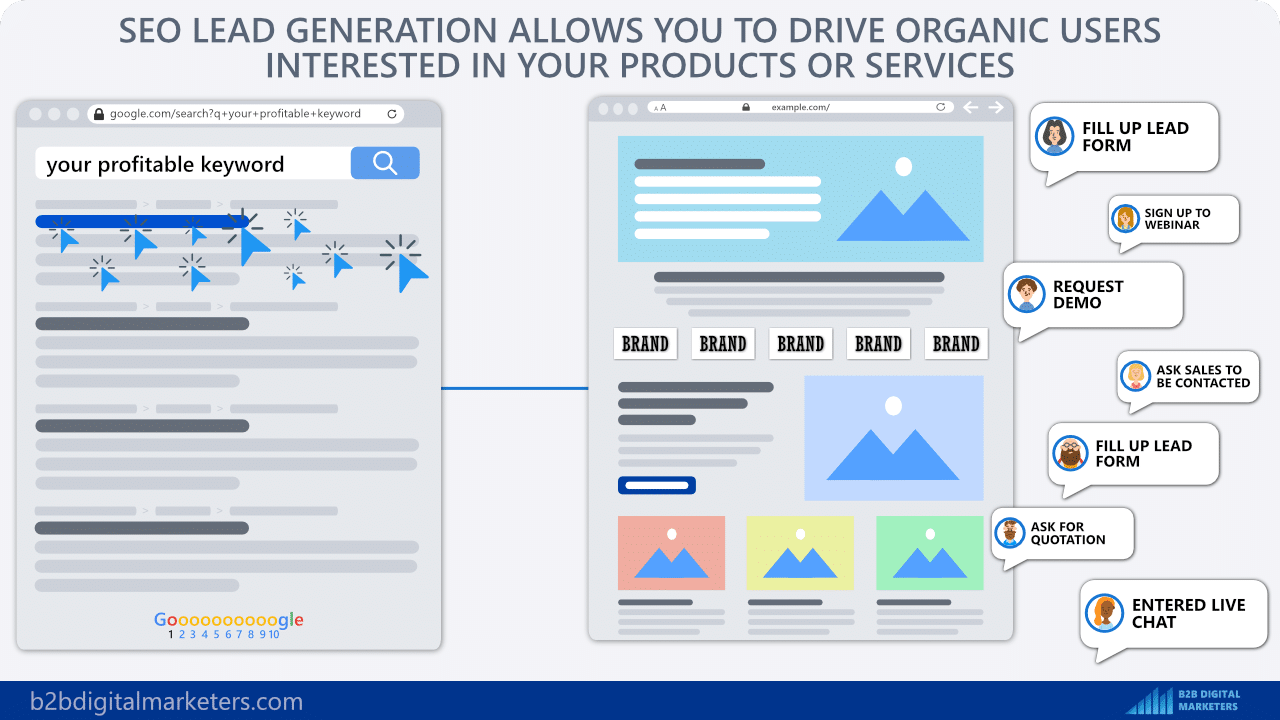
It involves proper keyword research, strategically planning your content creation, and starting building topical authority, so you can rank in top positions for your important money keywords in SERPs that actually bring organic traffic.
Why is SEO Great for Lead Generation?
SEO Lead Generation is important to businesses because it helps to generate high-quality leads with minimum investment and high ROI, and it can continually grow and scale over time even if the investment is stopped unlike PPC lead generation where continuing investment is required to get leads and once it stops it will not bring any leads anymore.
And for companies especially in B2B, lead generation is the most important marketing goal. In fact, 85% of B2B companies said B2B lead generation is their main objective. This is particularly true for those focusing on B2B SaaS lead generation, as software as a service providers need a consistent flow of leads to thrive.
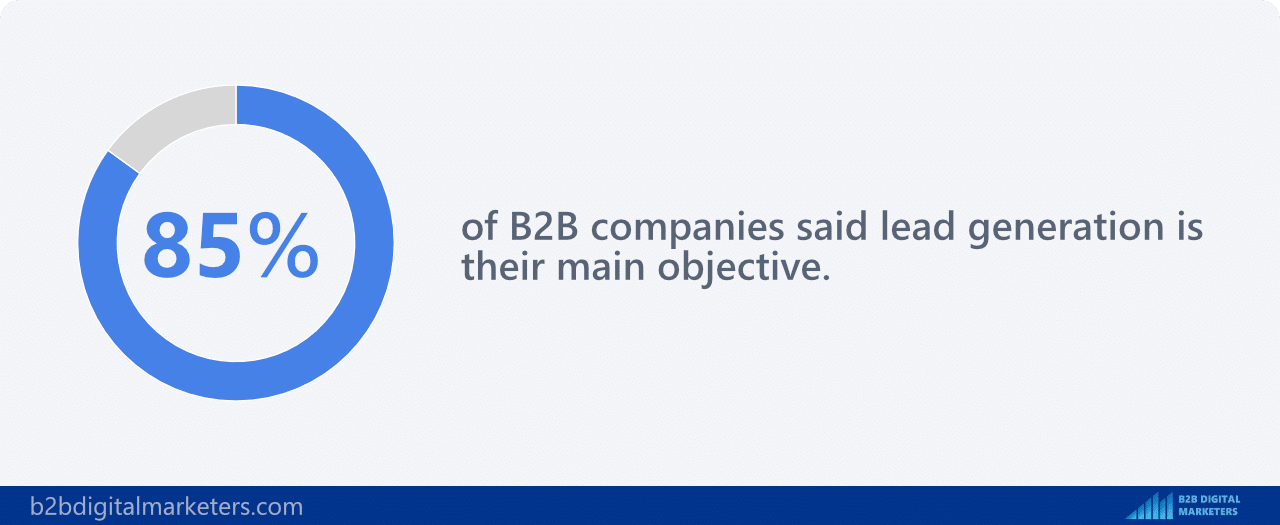
SEO lead generation can be arguably the best source of leads and revenue if you properly implement your SEO strategy. Following are the best SEO lead generation benefits:
Biggest Source of Leads
The first benefit of SEO lead generation and arguably one of the best reasons why you should start with SEO for lead generation is because you can bring the most leads for your business.
According to the research, 59% of B2B marketers think SEO has the biggest impact on lead gen.
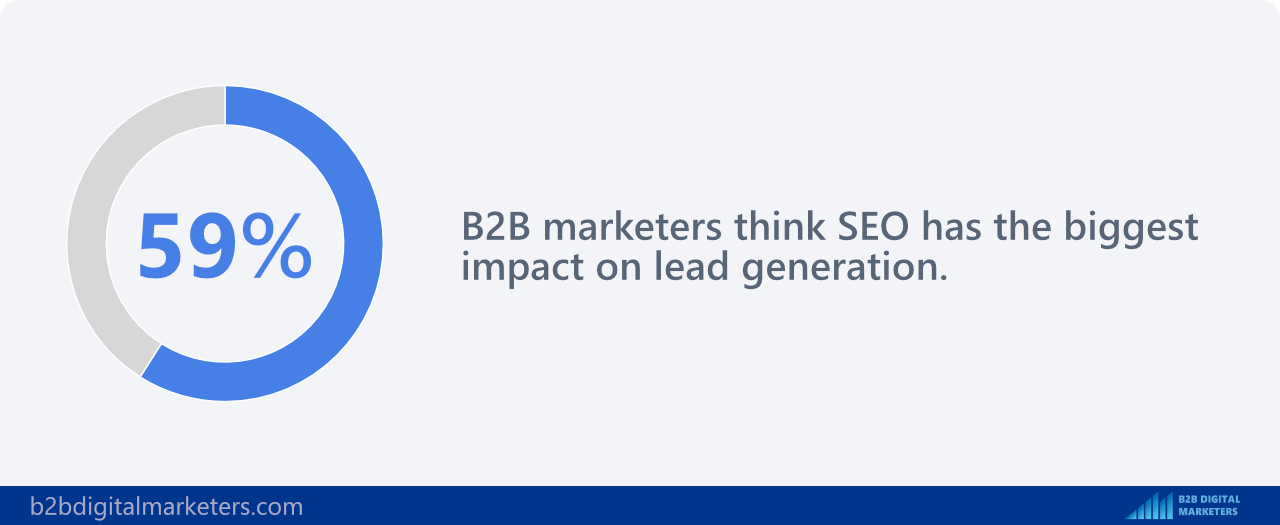
And this research was done in 2012 and since then the popularity of using a search engine for making purchases grow exponentially as more and more B2B buyers are turning to search to do their research.
In fact, 77% of B2B customers report that they research thoroughly before making a purchase, and a large number of B2B customers, 90% of them to be exact, start their B2B buying journey with an online search.
This means, your buyers are online, searching for information, and with SEO you can attract them to your website, provide the information they are looking for, build trust with them, and convert them into leads for your business.
Highest Quality Leads
The next important SEO lead generation benefit is that it can generate the highest quality leads for your business.
According to Plezi, the best conversion rate from MQL to SQL by channel is from your website or your SEO strategy at 31.3%.
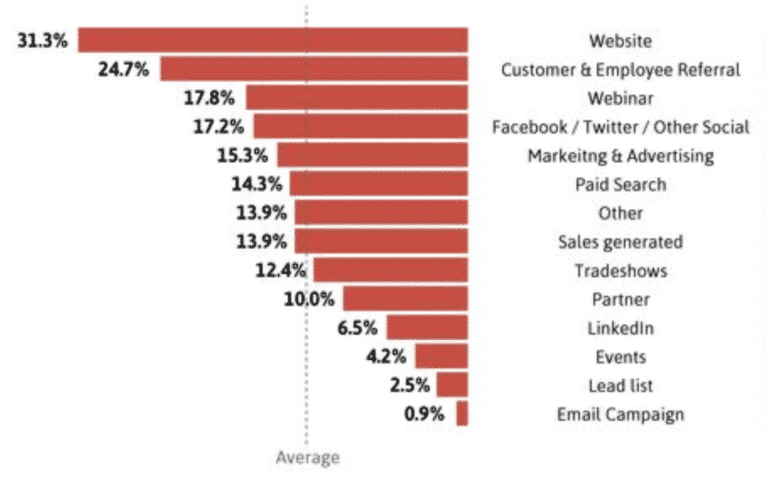
And from my experience, I definitely experience the same as SEO leads are converting the best from MQL to SQL and then to customers.
The reason behind this is because those leads are actually searching for your products or services as they need them, they did the research about what they actually need and your company and basically, they did a large part of the qualification process by themselves, which makes these leads extra high quality.
Low Investment & High ROI
Another reason why SEO lead generation is so important and beneficial to your company is that it requires a relatively small investment, and it yields a very high ROI.
First and foremost, the myth that SEO is free is not true anymore, and don’t expect you can do SEO lead generation without any investment at all, and I don’t mean paying wages, but actually investing into SEO techniques to drive leads with SEO.
But you can also expect a nice ROI if you implement a proper SEO strategy for your business. According to Terakeet, SEO ROI is between 5x and 12.2x based on their clients.
And a recent study found SEO to be the highest-ROI online lead generation strategy available to marketers.
Now, it’s also very hard to calculate this as nowadays, every channel is connected and none of the lead generation strategies are in a silo.
For example, SEO is often combined with email marketing and retargeting or PPC.
Myself, I always combine at least SEO with lead nurturing to improve the quality and conversion of the SEO leads.
However, I can say, that SEO ROI is definitely one of the highest nor the highest and it can be done for you as well.
Long-Term Strategy
And the last SEO lead generation benefit and a reason why you should hop on the SEO train is that it is a long-term strategy.
Now, some find SEO being a long-term strategy as a disadvantage as it can take a long time to see positive results, on average at least one year it can take to see some positive changes.
However, I have seen case studies that make those changes in a couple of months, but I would not bet on this. There are many internal and external factors that come into play.
But on the other side, if you have implemented only white-hat SEO strategies for your website, then it also takes time for SEO to lose its power.
And if you are a long-term thinker and want to see a long-term benefit from your investment, then SEO is arguably one of the best long-term marketing strategies for lead generation.
How to Generate SEO Leads? 7 Steps SEO Lead Generation Process
In Principle, SEO lead generation is a fairly simple process, what you need to do is to find highly relevant keywords to your products or services with commercial or transactional search intent, rank for those keywords and you will start seeing leads coming from SEO.
You will also want to refer to your products or services from other content on your website, to direct as much website traffic to your money pages.
However, then there is of course caveat to it. Here are some:
- To rank for your money and high search volume keywords is not so easy, you need topical authority to beat the competition.
- You cannot only target profitable keywords, in fact, you need mostly informational keywords.
- You probably also need to increase your website authority with link building.
- Just because you are driving organic traffic to your landing pages/product pages it doesn’t mean they will automatically convert. You need to build trust before and have some branding. Implementing a link building plan, which includes knowing how to track backlinks, not only boosts your website’s authority but also helps in building trust and branding.
So, in this article, I am going to address all these issues, so you can drive organic traffic to your product or service pages and I show you how to drive leads with SEO.
Here is my seven-step process for SEO lead generation:
Step #1: Understand Mapping Search Intent to Buyer Journey
The first step is you need to understand how search intent works and how you can map search intent to buyer journey to differentiate profitable keywords from informational keywords.
Search intent is the reason behind the searcher query and what type of content they expect to receive.
And understanding the search intent will help you to target the right SEO keywords that can generate SEO leads for your business.
In general, there are four types of search intent:
- Informational
- Commercial
- Transactional
- Navigational
And to recognize the search intent behind each keyword, you look at the type of content ranking in the SERPs and the keyword modifiers used in titles.
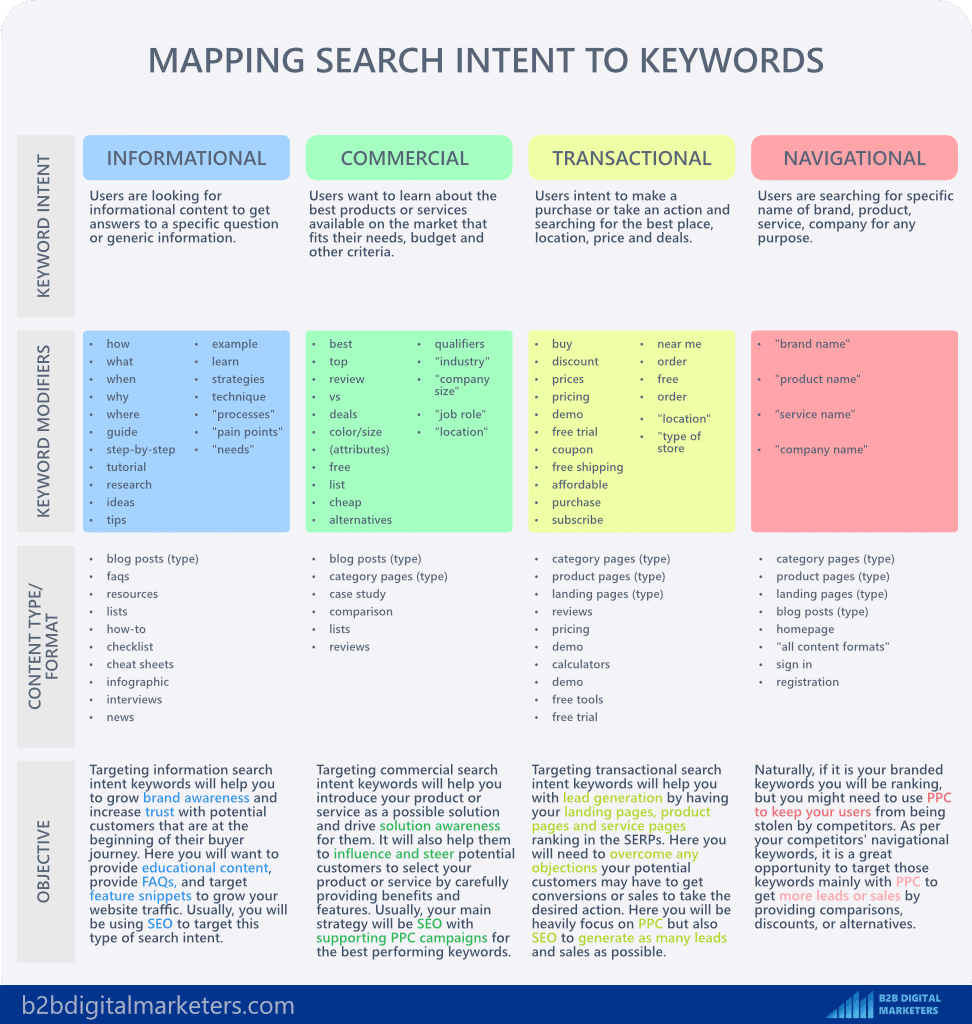
To simplify it, any keyword that is heavily product or service related is often commercial or transactional, and the informational type of content is of course informational type of search intent.
And this is important because by understanding the keyword search intent, you will be able to map keywords to the buyer journey.

And like this target keywords across all stages of the buyer journey, which will allow you to bring users from all stages in order to help you increase brand awareness, and trust with your potential customers and ultimately bring leads with SEO.

So, once you complete your B2B keyword research or B2C keyword research, you will need to assign the search intent to every keyword you have found.
Example of Simple Buyer Journey on Search
With that, to better understand how this works and how you can use SEO for lead generation, here I am going to give you an example of a typical user using a search engine that goes from seeking information, to actually making a purchase.
So, this is an example of how a typical buying journey happens, it starts with a trigger, which can be experiencing certain pain or needs. In this case, the person wants to grow onions. This is a pretty informational type of keyword.
However, then he learns he needs, different gardening tools to grow onions such as raised garden beds, soil, and gardening tools. So, he starts searching for the best gardening tools, best raised beds, and best soil and he will naturally use commercial type of keywords.
After he finds the one that fits his needs and budget, he will use a transactional or navigational type of keywords to make a purchase.
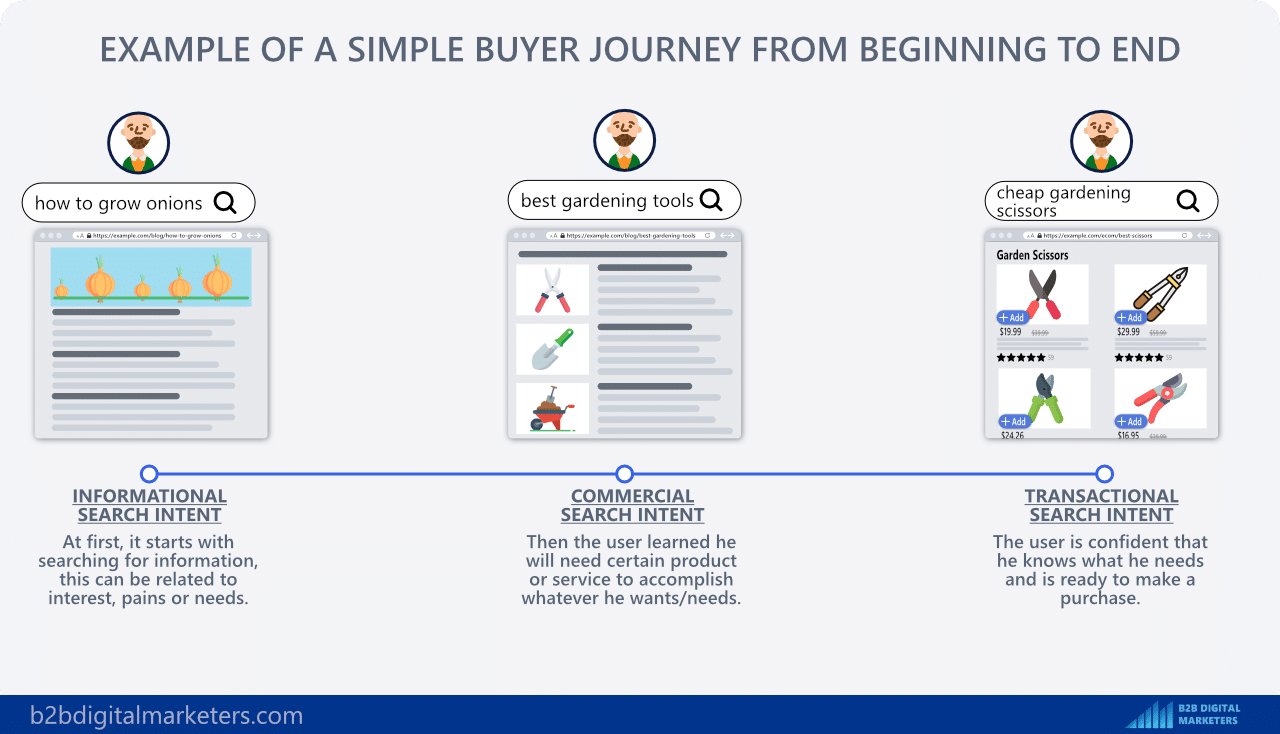
Remember, this works for both B2B and B2C buyer journeys. Of course, the B2B buyer journey is typically more complicated than B2C as several researchers, decision-makers, and others are involved in buying decisions.
According to Gartner, the typical buying group for a complex B2B solution involves six to 10 decision makers‚ each armed with four or five pieces of information they’ve gathered independently and must deconflict with the group.
However, they all do their research and use search engines to learn more about their needs and problems, products and services, and finally make a purchase.
Mapping Keywords to Buyer Journey Infographic
With that, here you can see an infographic to help you with mapping keywords to the buyer journey:
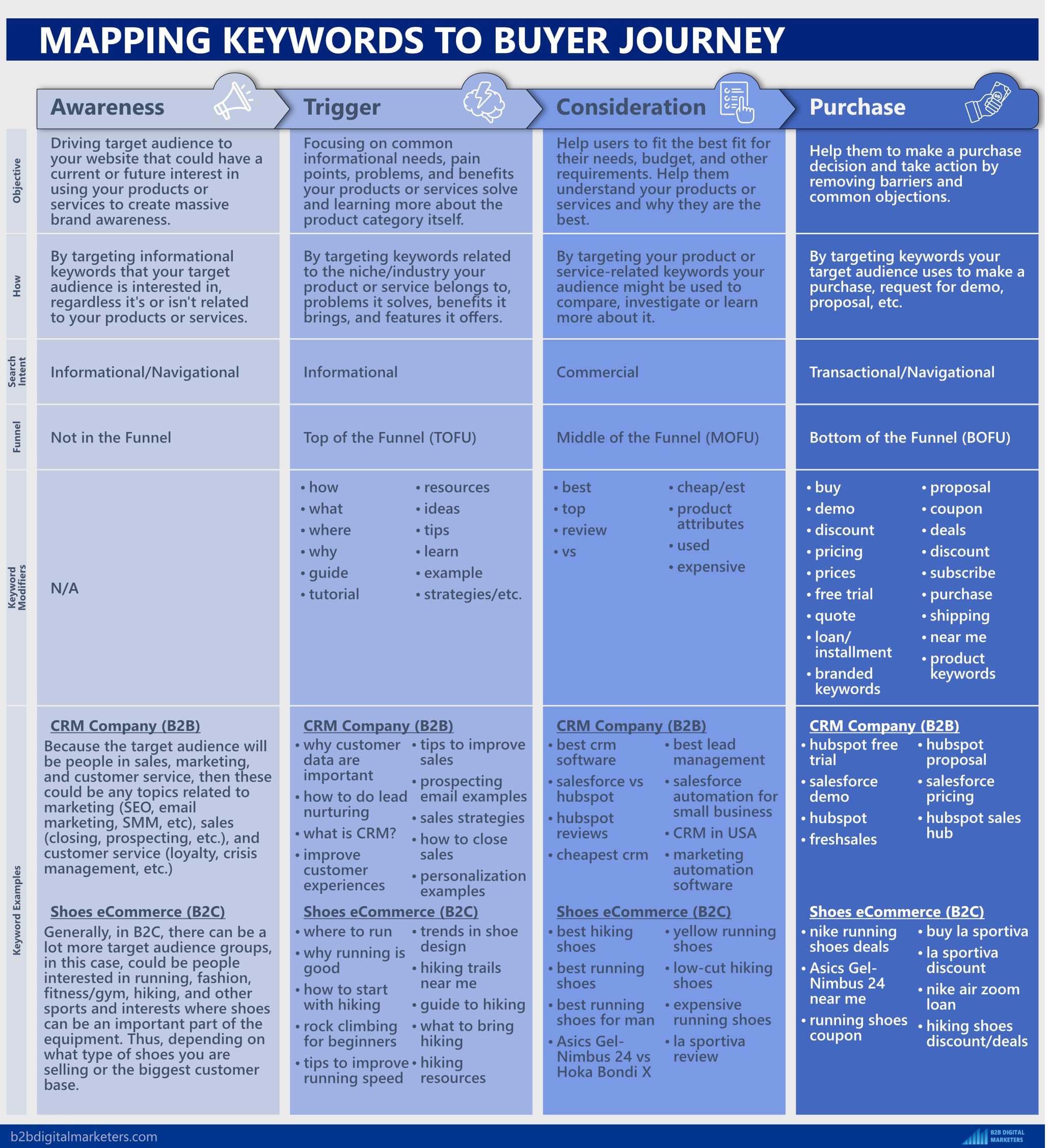
Download the full quality here.
Step #2: Find Your Product/Service Category Keywords
Once you understand the search intent and how to map your keywords into buyer journey, is time to do actual keyword research by searching for your product or service category keywords.
Category keywords are generic, short-tail keywords that generally describe a group of similar products or services that are having related characteristics. In most cases, your category keyword is exactly the same as your product category.
For example, if your main product category is running shoes, this is also considered a category keyword as keywords are words used by people to search for certain things, so product category and keyword category tend to be the same.
Here are a few more examples of category keywords across different industries:
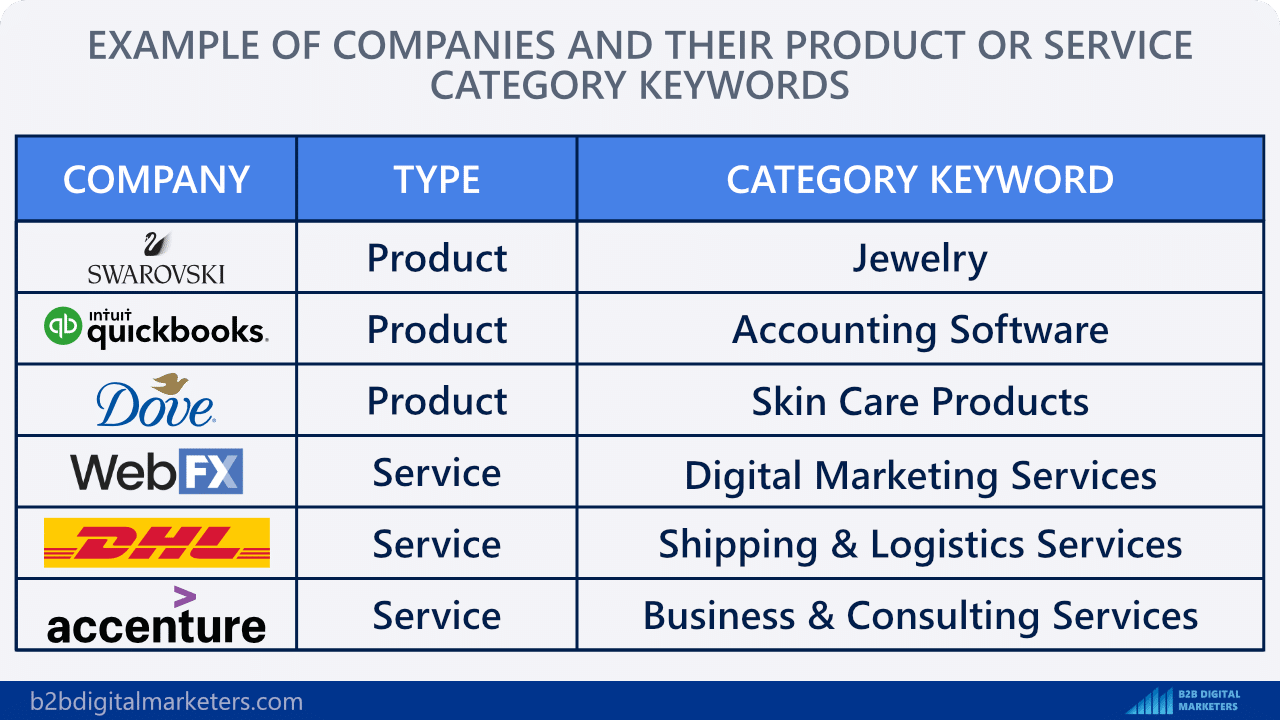
With that, category keywords help you to focus your keyword research to find the most related keywords to your product or service.
You want to also find your category keywords for all the products or services you are offering.
Lastly, you should also be aware of failed category labels. MIT research shows how important is to properly label your product to the right category. This also applies to your category keywords.

If there are more category product labels for your products or services, you need to make sure you select the most popular or commonly used within your industry.
If you are not sure, write down all the product categories and run them through a keyword research tool. This will show you which one is the most used keyword.

Step #3: Create Topic Clusters Around Your Product Category Keywords
Now, once you have found your category keyword you will want to create a topic cluster around them in order to start building topical relevancy and authority which will help you rank for your most important keywords.
So, to create your topic cluster, you can use a keyword research tool, in this case, I will be using SE Ranking Keyword Research tool.
If you don’t have any SEO tool, then I recommend you try SE Ranking, you can use my link to get 14 days of free Pro subscription so you can follow me along the way.
For example, let’s say I am selling project management software, which is also the category keyword, and to create a topic cluster I need a seed keyword, which in this case is “project management”, but for category keywords like “running shoes” the “category keyword” is also the “seed keyword”.
Here are more category and seed keywords examples to get a better idea.
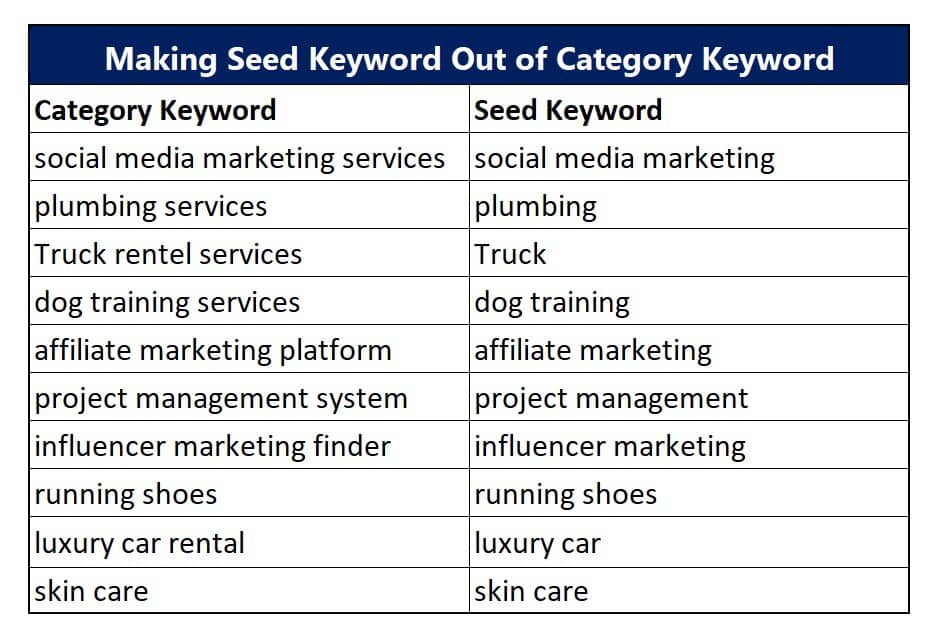
Once I have my seed keyword, then I pop it into the SE Ranking keyword research tool, select my target location and hit “Analyze”.

Here you will get a high-level overview of the analyzed keywords such as the keyword difficulty, estimated monthly search volume, CPC, and the keyword ideas reports. From here I’ll go to the “Keyword Suggestion” report.
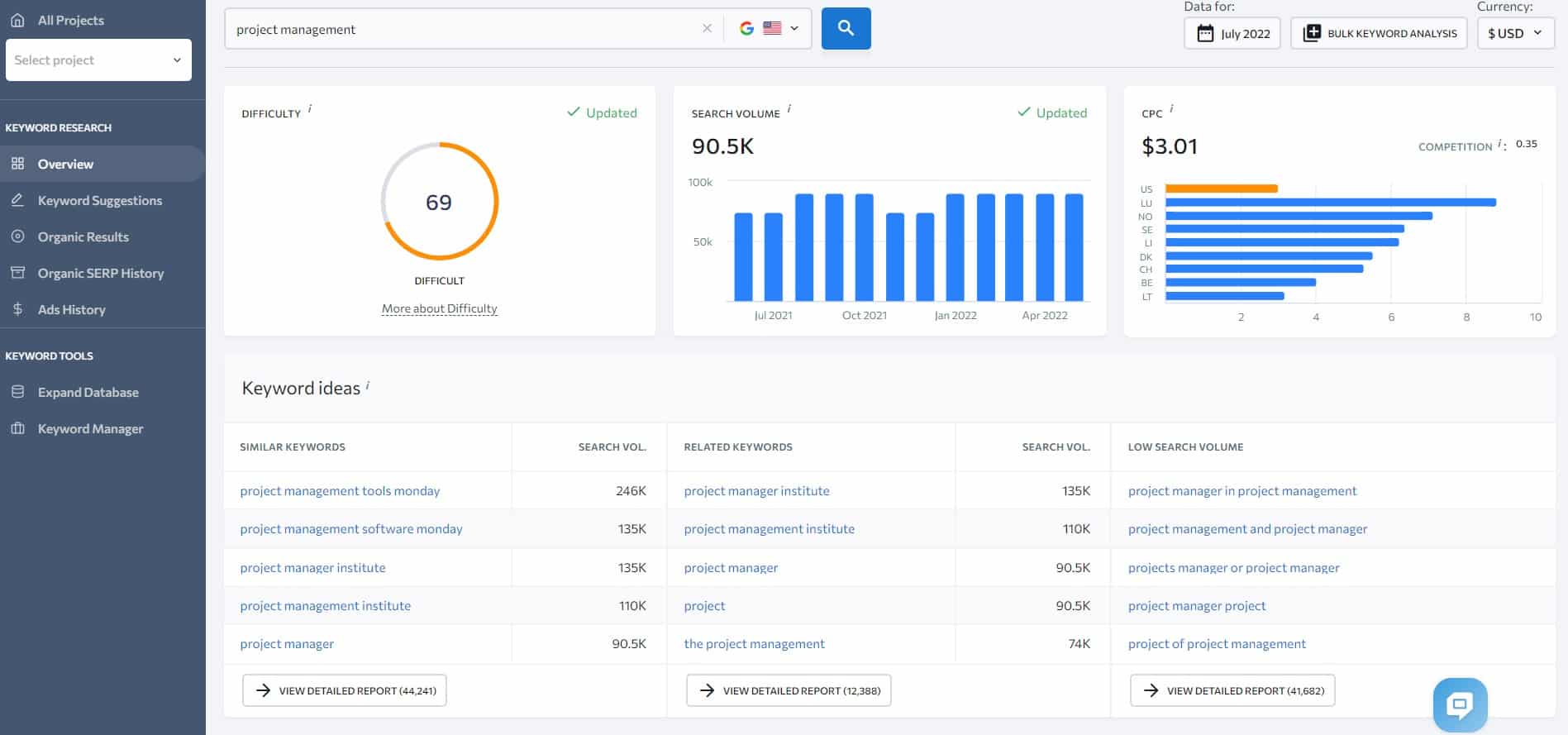
And here I will scan all the keywords to find any related topics/subtopics to the project management, such as “project management courses”, “project management”, “project management techniques, et cetera.

Basically, I am searching for related subtopics to my main topic “project management” to create a topic cluster.
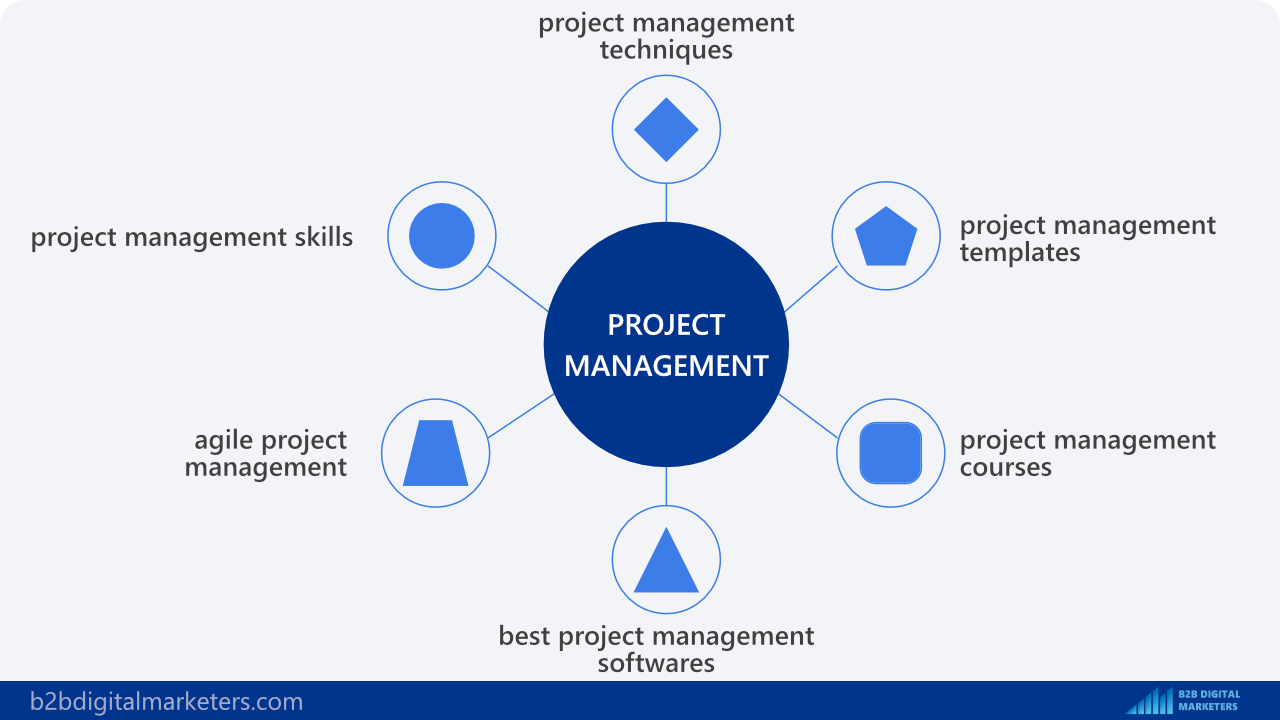
And you will want to create topic clusters from all the category keywords you have created.
Step #4: Find More Related Keywords
The next step is to find more related keywords and create more related topic clusters for your industry.
In most common industries and niches, you can find plenty of different and relevant topic clusters and keywords to expand your keyword list.
So, with that, here are four of my favorite keyword research techniques to find more related keywords:
1. Build More Topic Clusters from Closely Related Keywords in Your Niche
The first and best way to expand your keyword list is to create more topic clusters from keywords that are closely related to your niche or industry.
For example, my category keyword is SEO and under SEO there are many different relevant topics and subtopics, that can become topic clusters such as “link building”, “keyword”, “on-page SEO”, “technical SEO”, “local SEO”, “backlinks”, “search engines”, “WordPress” and many, many more.
Now if you know the industry well, then you can easily think of these super related, yet broad topics within your industry, that can become topic clusters.
However, if you are not so familiar, then you can do that from keywords you have already found.
For example, for SEO I found the keywords “seo lead generation”, “seo keyword research”, “seo link building”, et cetera. So, I already have the ideas, I just need to broader the keywords to create more topic clusters, so from “seo lead generation” I can go to “lead generation or from “seo keyword research” to only “keyword research” to create topic clusters.
And you can do the same, most likely, during your keyword research you can find such opportunities to create more related topic clusters.
2. Check Out Industry Terminologies and Glossaries
The next keyword research technique to find more related keywords and also find topics to create more topic clusters is to check the industry terminologies and glossaries.
For example, if I check the SEO Glossary, I can find plenty of great topic ideas related to the SEO niche, including some broad terms to create topic clusters such as “keyword”.
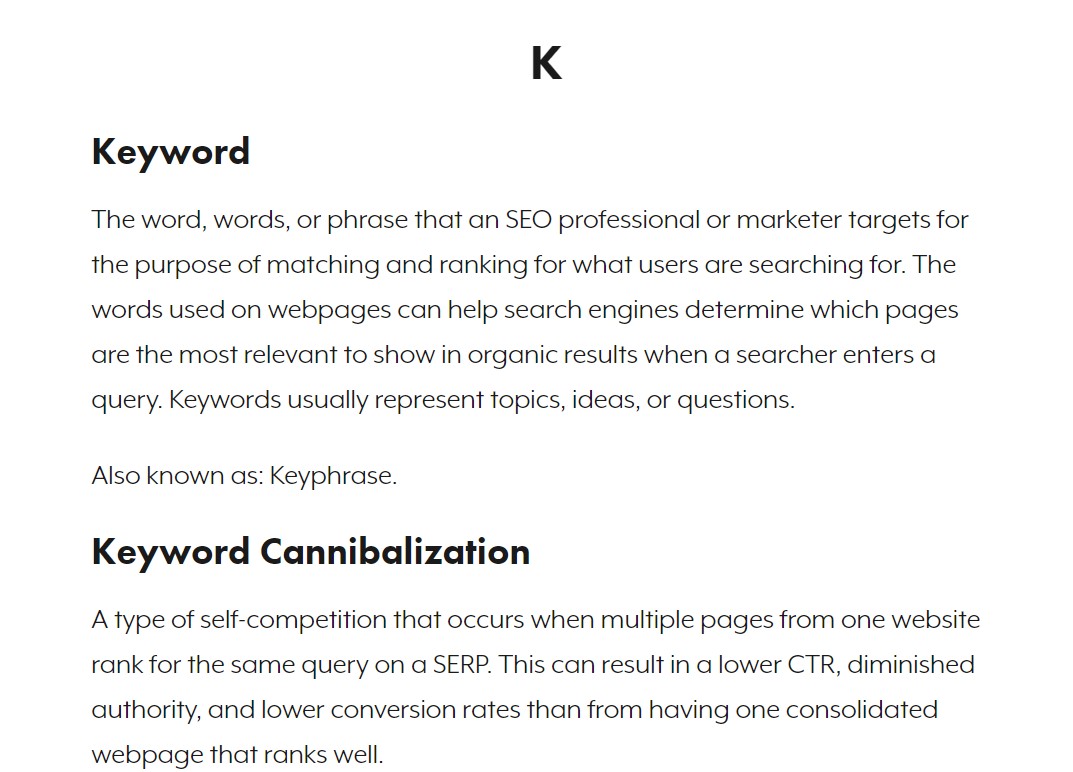
Or Link Building.
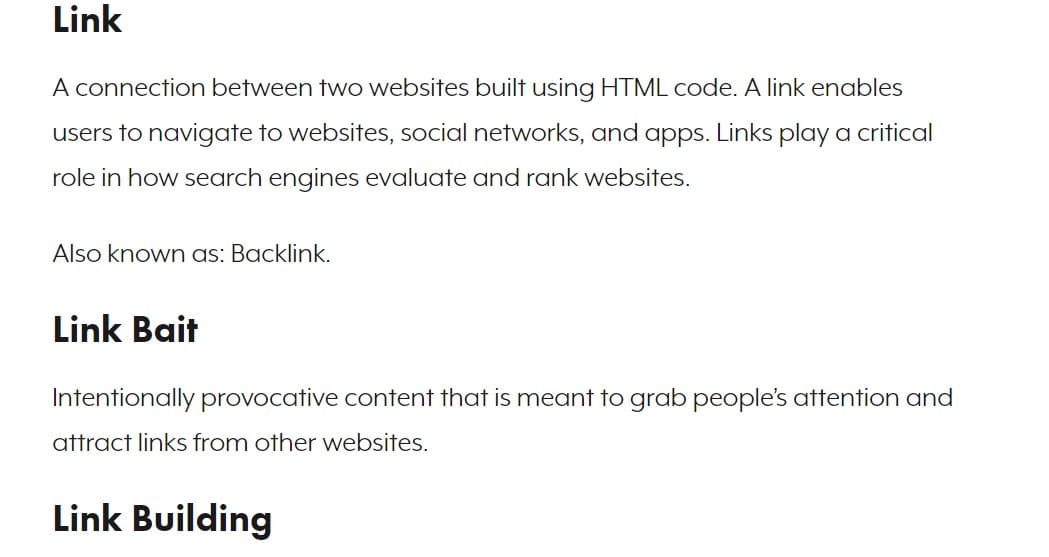
Again, this can be a great way to get more keyword ideas, find more related topic clusters and even find more related subtopics to topic clusters and the best way is that it works for every industry.
3. Write Down Common Pain Points of Your Customers
Another keyword research technique I like to use for SEO lead generation is to write down common pain points your customers are experiencing. Preferably the way how they describe it.
I love this technique because it helps you to find keywords used by your customers when they search for your products or services.
Because your customers may not know the proper way to describe the problem they experience or type the right keyword to find the right solution for their problem.
For example, instead of “ceiling plumbing leak” they will say “water leaking from ceiling”.
So, what you want to do, is to collect common pain points from your customers and write down how they describe them.
And then from there, you want to pick the important keywords to use in your keyword research.
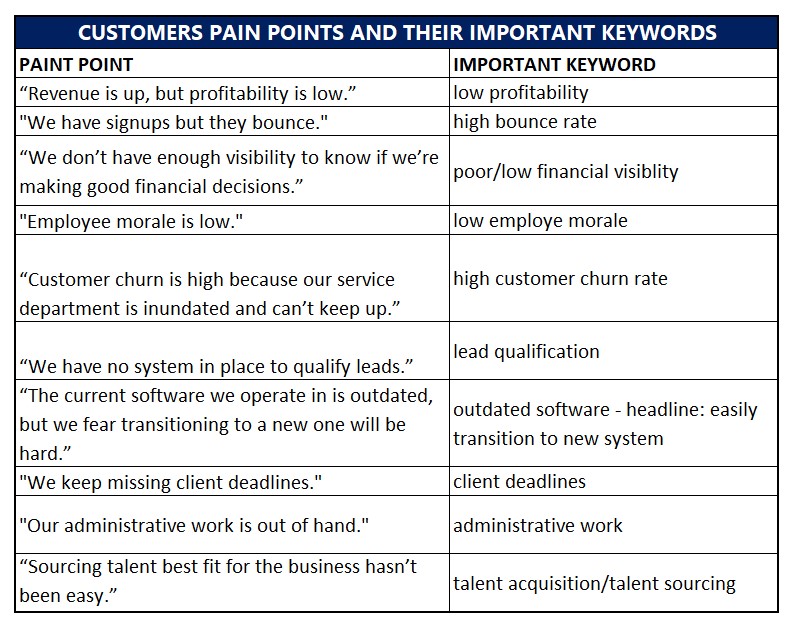
4. Niche Up from Your Current Topic Cluster
This only works for some, for example for “project management”, you can niche up your keyword research to the keyword “project” only.
Or if you are providing plumbing services, then you can niche up from the keyword “plumbing” to “house maintenance” or “building maintenance” and create a topic cluster only from those keywords that are related to your industry such as “house maintenance checklist” where you can easily include to check for plumbing or water household issues.
Basically, you want to go from your topic to a more generic topic, but still select only the related subtopics to your niche or industry.
So, you must be careful with your keyword research as the more broad or generic the keyword becomes, the more you will need to filter out the keywords to find only the ones related to your industry.
For example, for a project management software company, the keywords “school project” or “The Adam Project” are totally unrelated keywords.
With that, you want to use these and other keyword research techniques to find more related keywords in your industry to expand your keyword list. Your goal should be at least a list of 500 highly relevant keywords.
Step #5: Keyword Prioritization & Content Creation for SEO Lead Generation
Alright, once you have your list of keywords, the next step is to prioritize the right keywords so you can create SEO-friendly content on your website in order to bring organic traffic and generate leads from SEO.
When it comes to prioritizing which keywords you should target first, you essentially should focus on low-competition keywords that bring you results with minimum effort, and as your website authority and topical relevance grow you can target more and more competitive keywords.
However, while this approach is not the worst, I believe from a business perspective you want to clearly show Google what will be your website about.
That’s why you want to focus on Semantic SEO by targeting your main topic cluster keywords but also on relevant low-competition keywords in order to bring organic traffic as soon as possible and generate leads as well.
So here is how you should prioritize your keywords:
1. Start Targeting Keywords from the Main Topic Cluster
First, you want to start targeting keywords from your main or most important topic cluster.
This topic cluster should be around your bestselling or signature product or service that your company is offering.
The idea is pretty simple, here is how you do it:
- Select your most important topic cluster: As said, this should be around your #1 best-selling or signature product or service your company is offering.
- Target the main transactional keyword from the topic cluster: Within your topic cluster, you should have one main transactional search intent keyword to create your product or service page. This will be your main lead generation page for that one topic cluster.
- Target 1-2 commercial keywords from the topic cluster: After that, you will want to target keywords with commercial search intent. Commercial keywords are great to introduce your solution to potential prospects and move them further in the buyer journey. Plus, they will play a big part in SEO lead generation strategy.
- Target 5-10 information keywords from the topic cluster: These will be your supporting pieces of content to not only create brand awareness for your brand and your product or service at the early stage of the buyer journey but ultimately start building the topical relevance and authority for all your pieces of content, so you can rank your commercial and transactional keywords in top search results in order to generate leads from SEO.
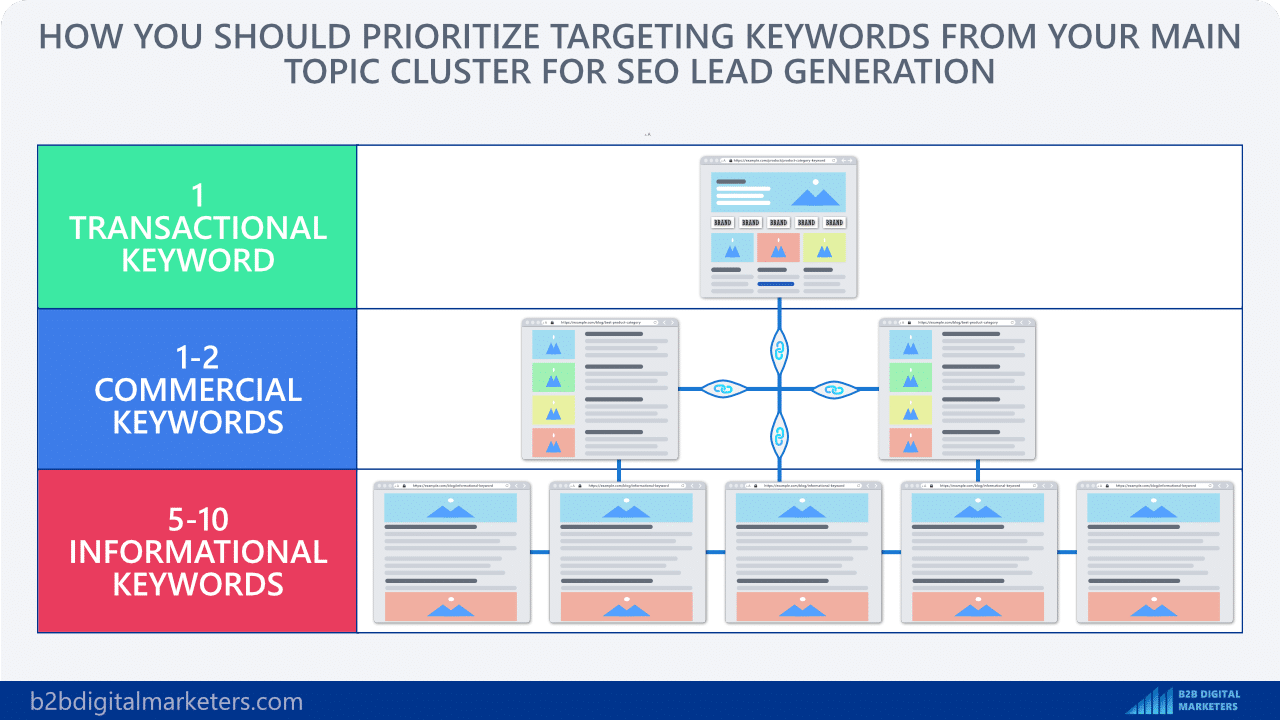
For example, here you can see a table of keywords for the topic cluster project management.

And here is an order of how I would target the keywords
- Keyword: project management system – This will be my product page categorized under the product category. This is my transactional keyword.
- Keyword: best project management softwares – This will be a blog post with a list of best project management softwares with mine on the top. This is my commercial keyword.
- Keywords: project management, agile project management, project management techniques, project management skills, project management templates, construction project management, and agile vs waterfall project management – These will be my informational keywords to build topical authority and trust with Google.
2. Information vs Commercial & Transactional Ratio
The next what you should be aware of is the information vs commercial & transactional ratio of your keyword targeting.
Of course, you don’t want to only target 5-10 information keywords 1-2 commercial keywords, and 1 transactional keyword, but as many as you can.
In 2020, Google did a big update specifically targeting affiliate sites and the ratio of commercial vs information content. However, it does not only affect affiliate sites but you as well, in the end, you are affiliating your product or service in your articles.
And according to Matt Diggity’s research, the commercial vs information content ratio is important to avoid any loss of rankings or being able to rank in Google searches.
And the average % for informational vs commercial content is around 70% and 30% respectively.

So, if you want to generate leads with SEO I also recommend keeping this ratio.
Also, later you will better understand why having informational content on your website is so important so you can rank your commercial and transactional keywords on top of the search engine result pages.
3. Target Related Supporting Low Competition Keywords to Your Topic Cluster
Once you build your topical and content foundation, then I recommend you target around 10-20 low-competition keywords. These keywords can be with commercial or informational search intent, just remember about the content ratio I’ve talked about.
The reason why is because at first, you won’t be able to rank for the keywords from your main topic cluster as probably these keywords are very competitive.
Therefore, the next stage is you want to target related supporting low competition keywords to your topic cluster in order to start generating at least some organic traffic from your SEO and potentially SEO leads as well.
For example, for my project management topic cluster, I could target any of these keywords.
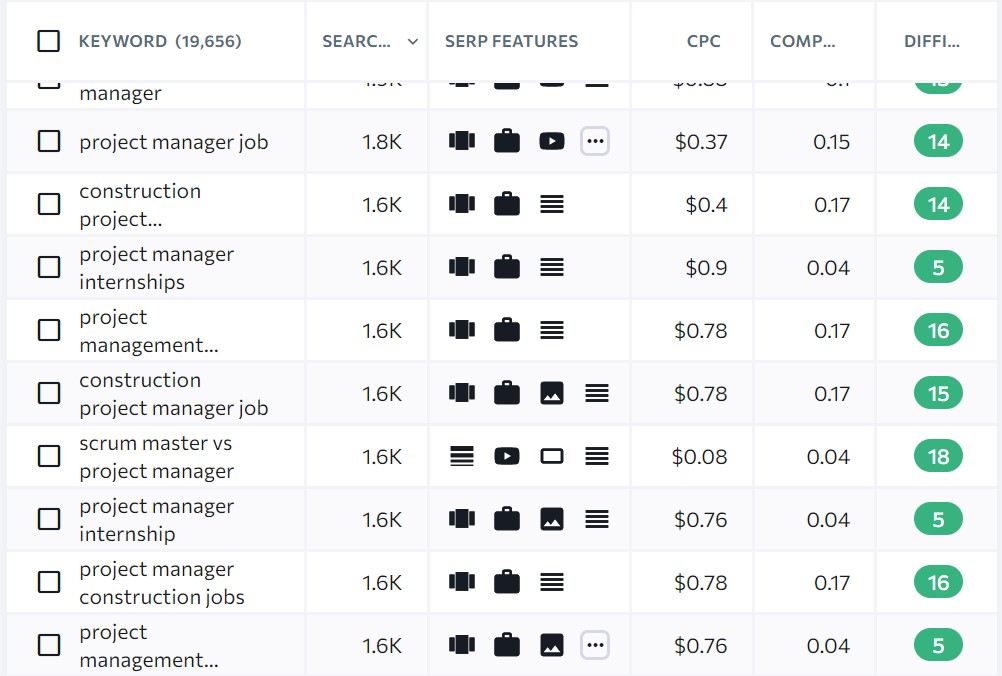
These keywords do not need to be super relevant but somewhat relevant to your topic cluster, so you can include an internal link in a natural way to at least one of your contents from your topic cluster.
Plus, it will further help you increase your topic authority and relevance and improve your ranking. Because the more organic traffic, you generate the bigger trust you earn from Google, and they will let you rank for higher search volume keywords.
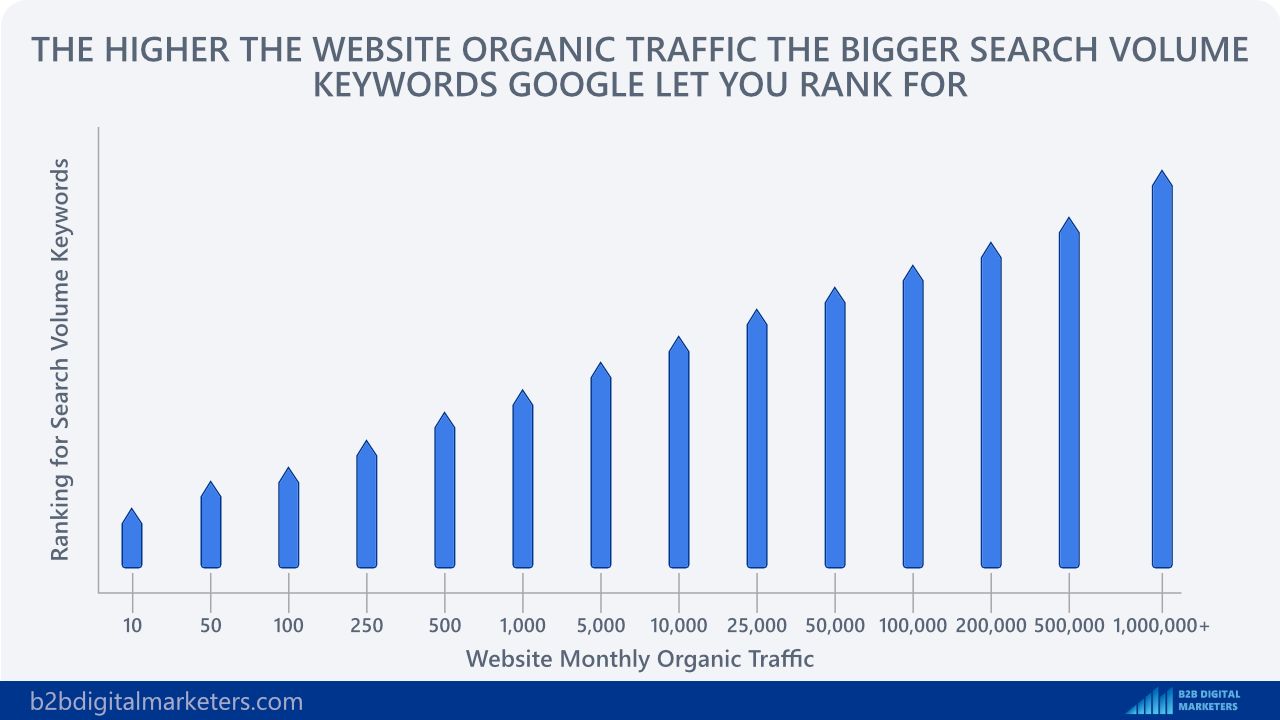
4. Move to The Next Topic Cluster
Once you have built your foundation, and targeted low competition keywords to generate traffic, then you want to move to the next main topic cluster and repeat the process for all your topic clusters.
And once you run out with topic clusters, then you can target the individual yet relevant keywords to your products or services.
However, for any lead generation purposes, you need a complete website, so you probably create all your product or service pages first.
And then you can follow this process it doesn’t matter if you already have all your product pages. This process is just a guideline to follow, but nothing is written in stone, and you can adjust your keyword targeting plan as you go along and get more data from your analytics, lead generation, and keyword ranking.
Step #6: Build Proper SEO Internal Linking Strategy
The next step is to build a proper SEO internal linking strategy across your topic clusters and low-competition keywords.
Building a proper SEO internal linking structure is important for your website and it is one of the fundamental parts of a successful SEO strategy.
SEO cross links are also arguably one of the most important Google ranking factors that you have absolute control over, and they can hugely influence your ranking, impressions in Google searches, time on your page, and even lead generation.
For example, I have run a little experiment on my website. As you can see in this picture, once I have focused on the internal linking strategy, my website impressions in Google searches skyrocket. Then I deleted around 50% of my internal links and my impressions sunk like Titanic.
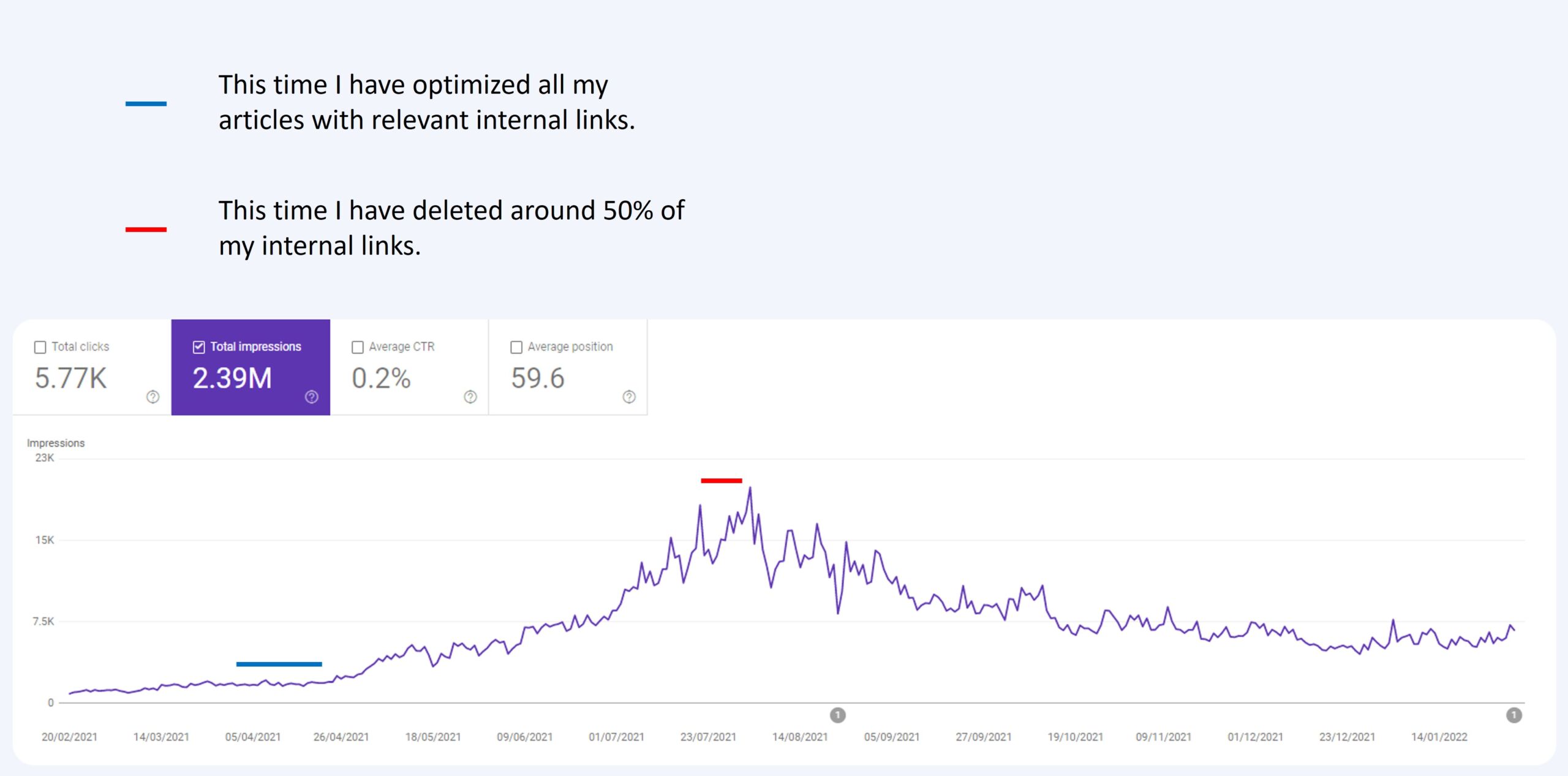
And this is not just me, but I have seen this happening across many different websites used by Agencies to get quick wins.
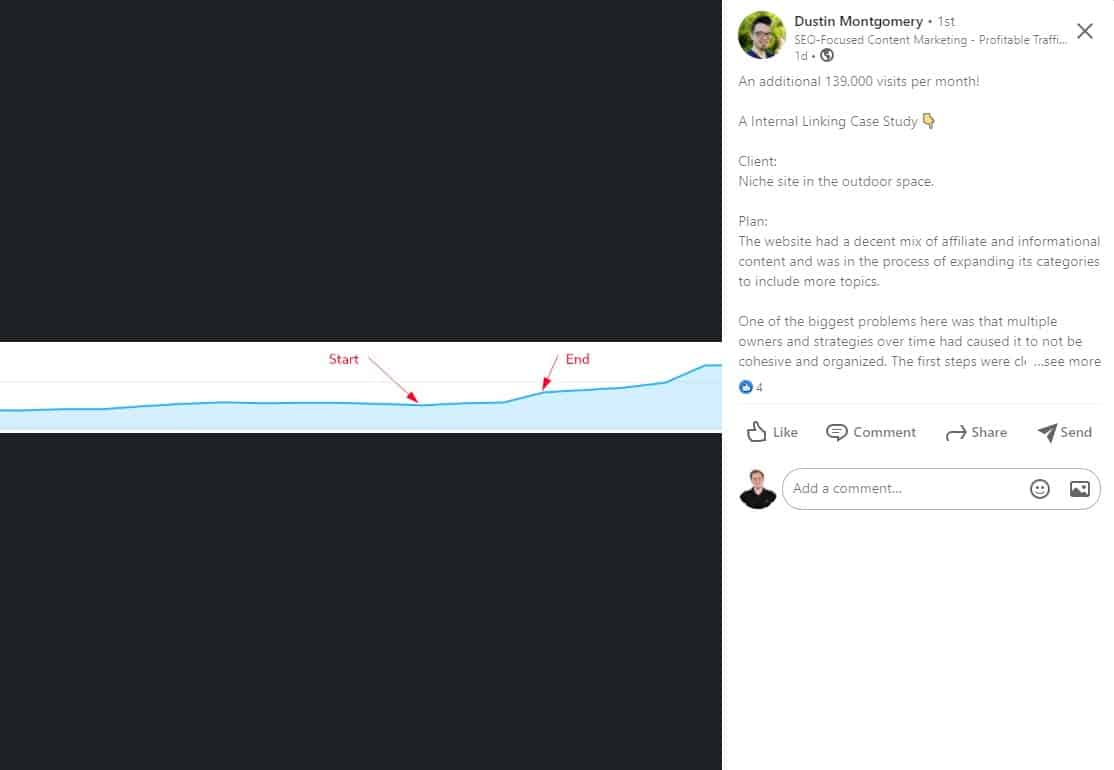
With a proper SEO internal linking strategy, you can improve many aspects of your website such as:
- Google uses internal links to crawl your website, thus you can improve your crawlability which can result in more impressions and better ranking.
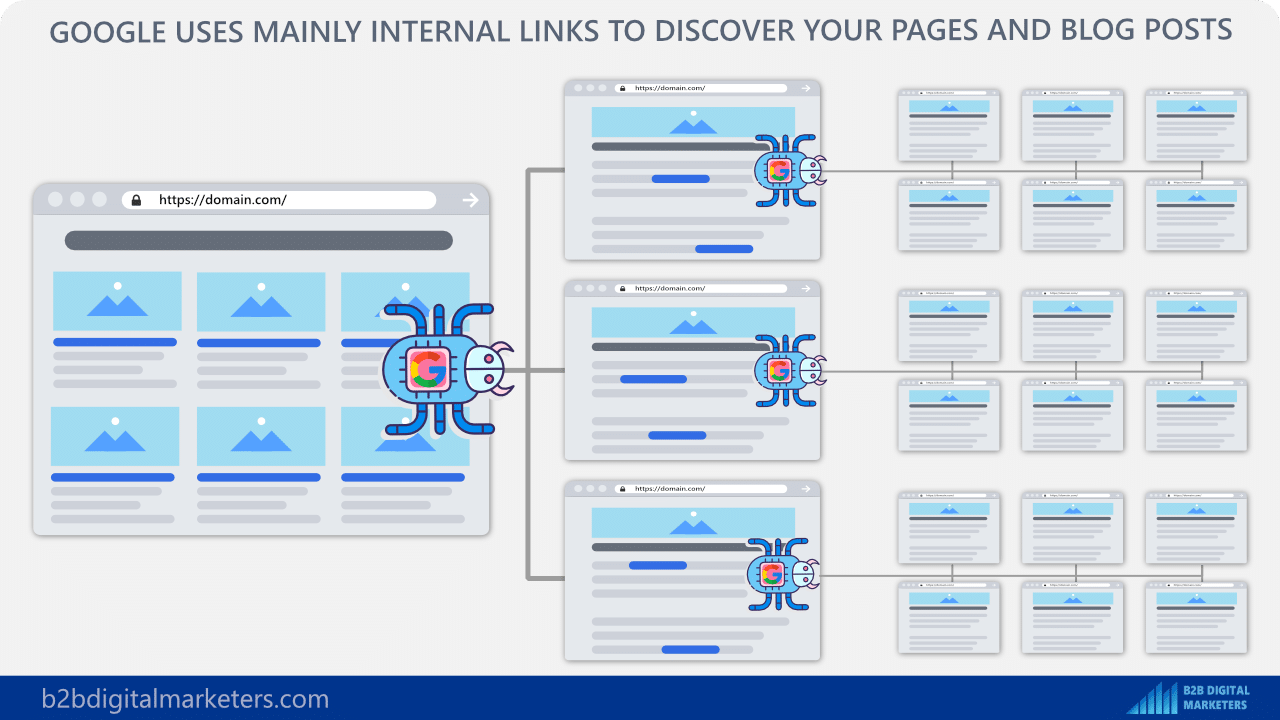
- Internal links help you to indicate to Google which pages are the most important on your website.

- You can lower your click depth to keep your pages in click depth between 1-3 for better crawlability and user experience.
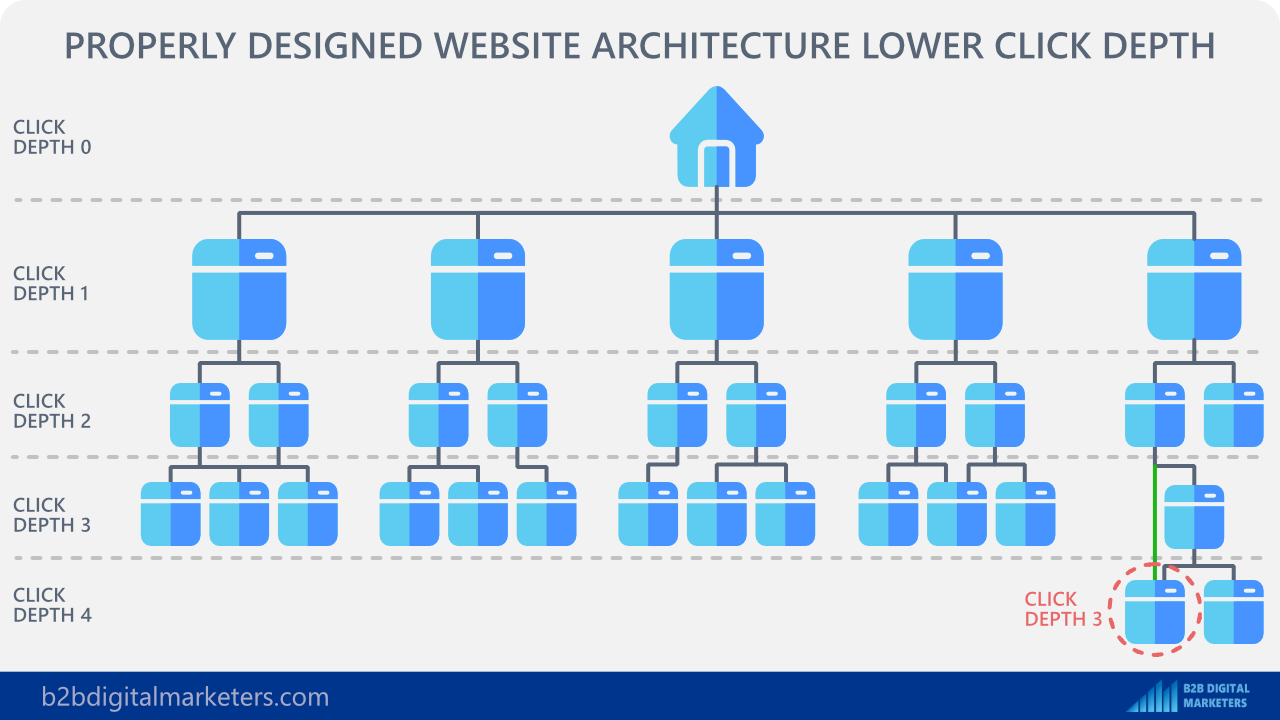
- You can give a better understanding of what your page is about. Google is looking at the anchor text of internal links to get a better understanding of the page.
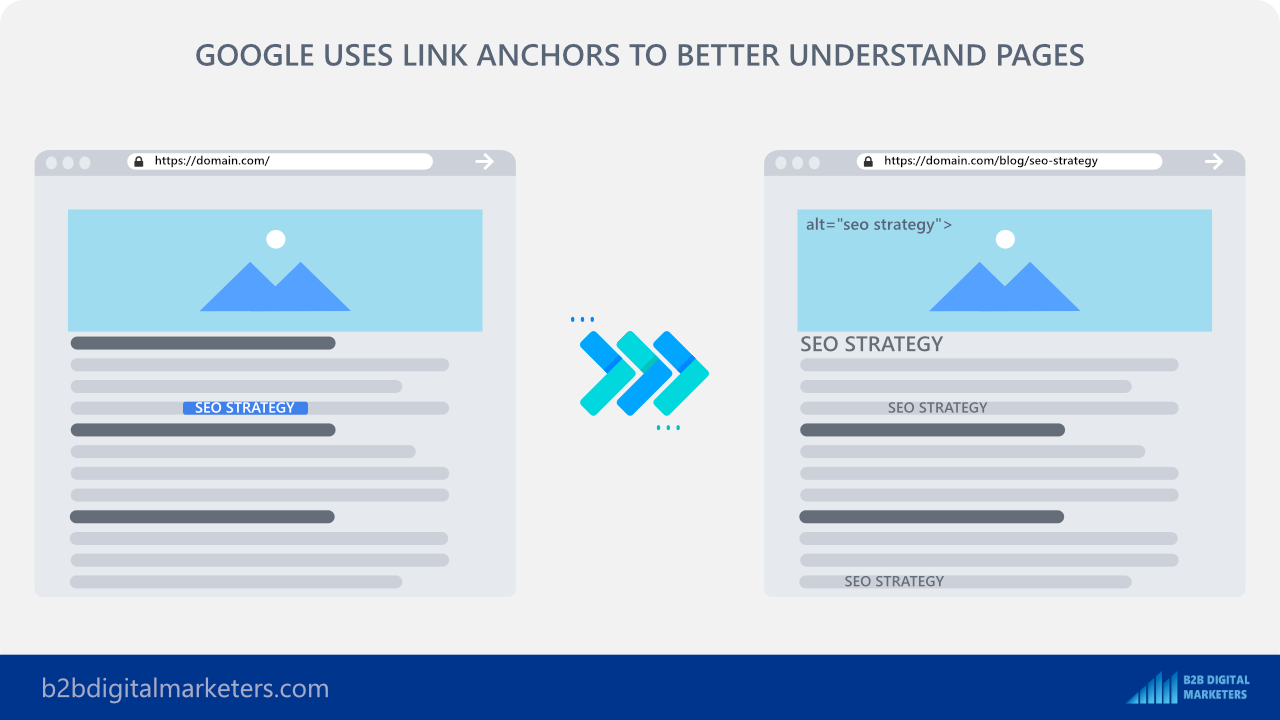
- You can remove any orphan pages or silo of orphan pages on your website.
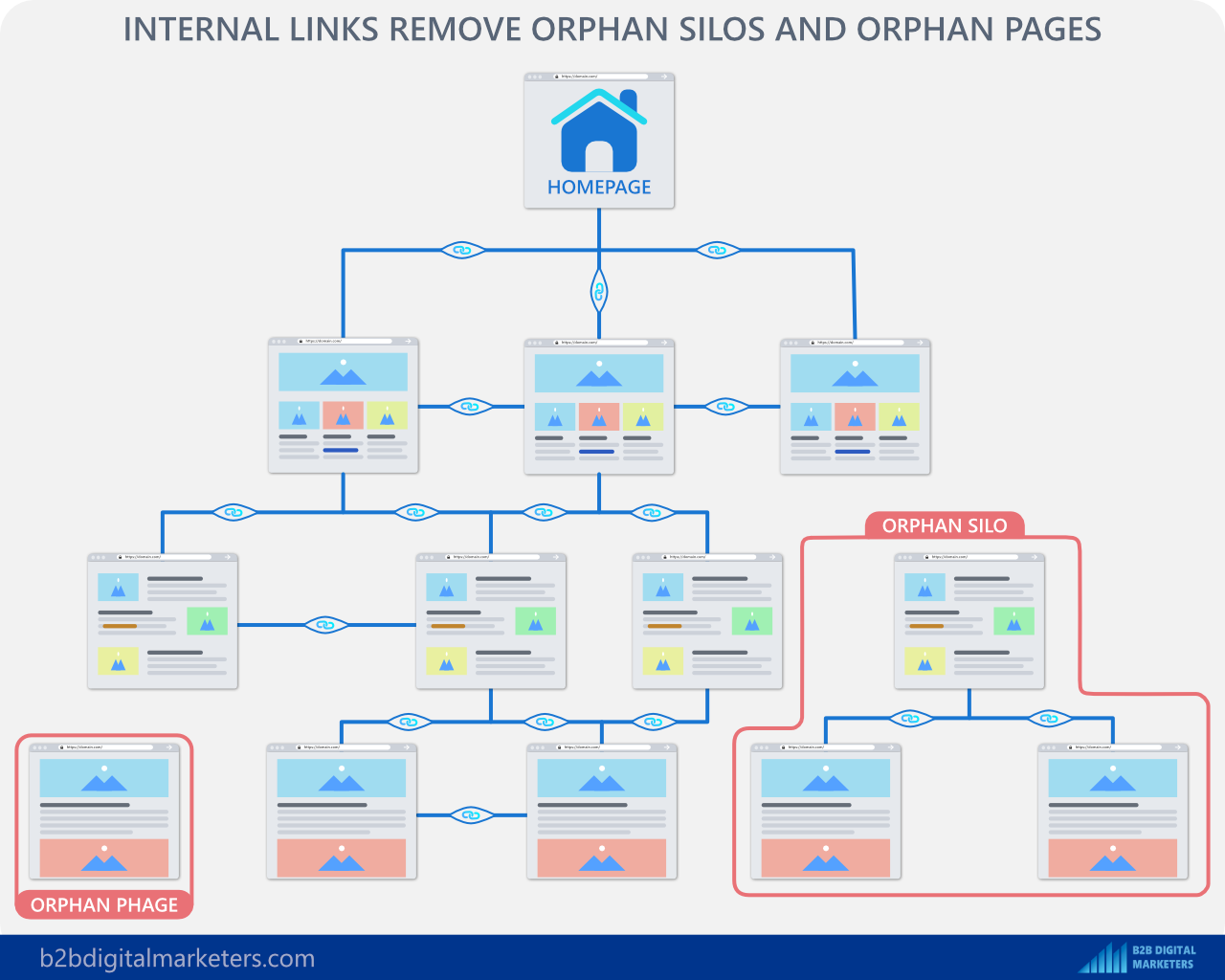
- Internal links are an essential part of building proper website architecture and connecting semantically related content in order to improve ranking and user experience.

With that, you also want to build proper SEO linking strategy for your topic cluster. You will want to create semantically related internal links from all your articles to your commercial and transactional pages and of course between each other.

Of course, your topic cluster should not be in a silo and you should link from other of your articles where it makes sense and you mention the keyword or anything related to the other articles regardless they are in the same topic cluster or not.
And this will help you to send a strong signal to Google about what your pages and website are about and improve your topic authority and relevance.
Targeting relevant SEO keywords in your niche and industry on your website will improve your overall Google E-A-T score as the more content you produce and of course better quality, the more Google will see you as authoritative, trustworthy, and expert in your industry.
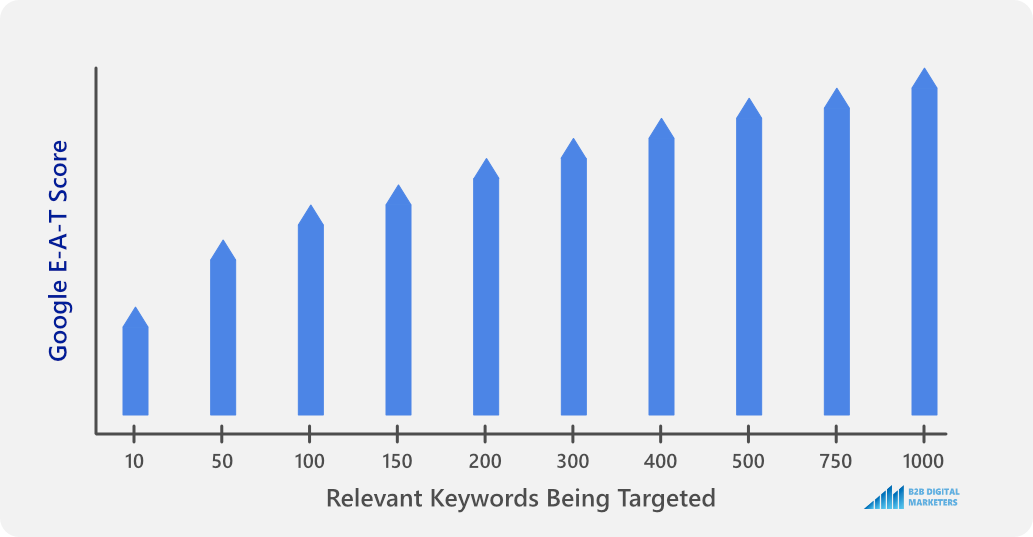
And you will be also able to rank for more related search terms which can improve your organic traffic and more leads from your B2C or B2B SEO strategy.
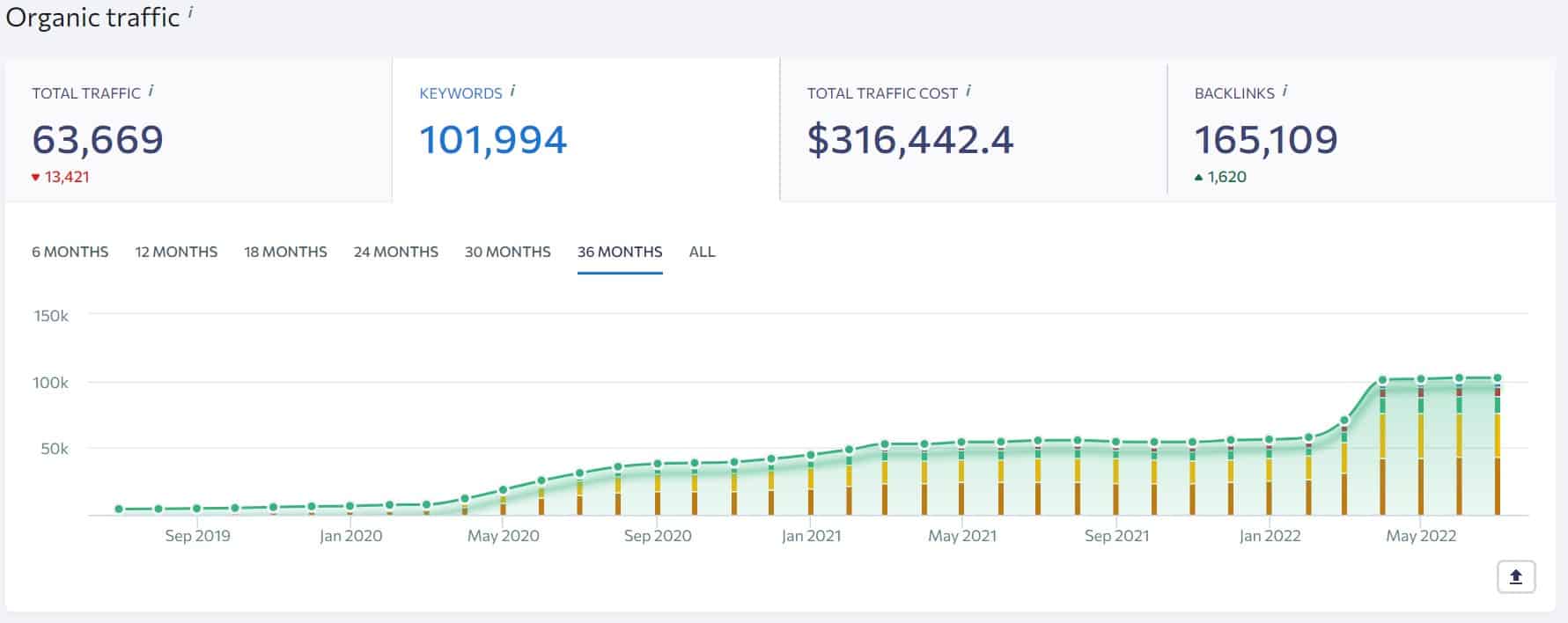
Step #7: Strategically Build Backlinks
And the last step of the SEO lead generation process is to strategically build backlinks to your content in order to rank for your most important keywords, but also generate organic traffic as soon as possible.
Here is the deal, the reason why you cannot simply target only transactional keywords and build only links to your product pages is that “naturally” this does not happen that often and there are only a very few occasions when a website would link to your product page.
Definitely not enough to build the website authority to rank in top positions in today’s time and if you would do it, Google would quickly recognize it and penalize you.
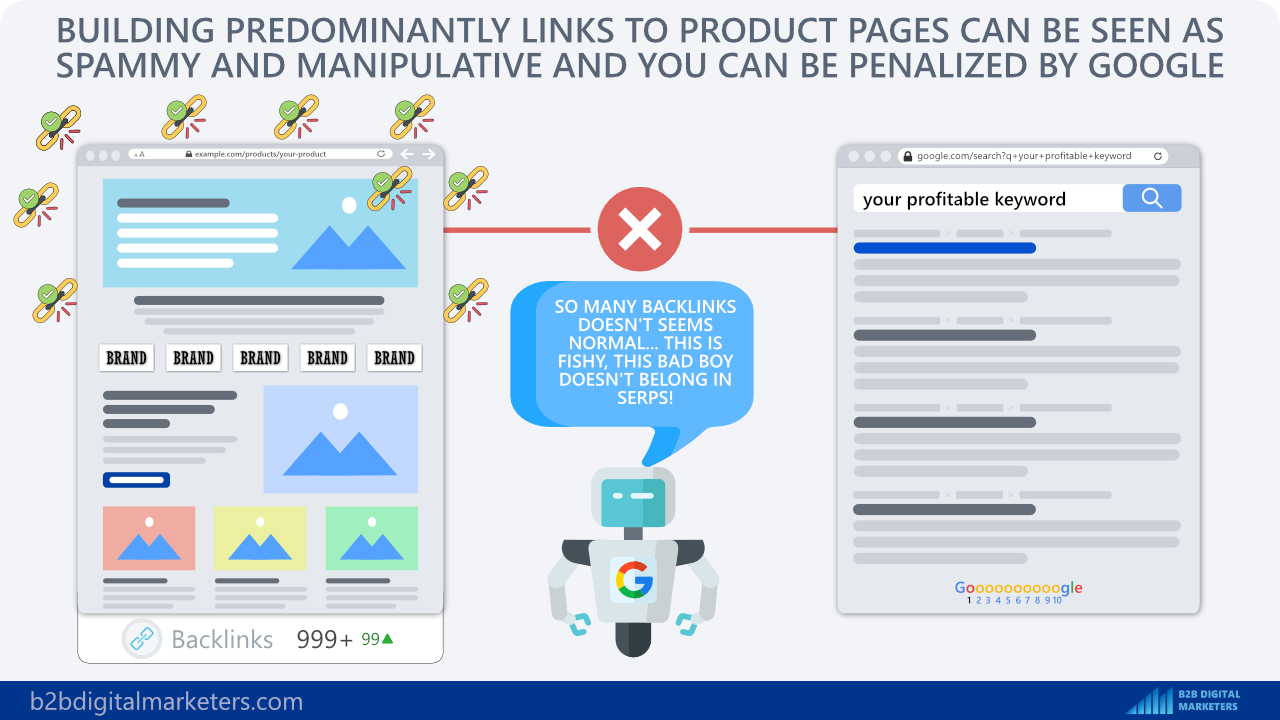
However, informational content is way more likely to naturally attract high-quality backlinks, so it’s safer to build more backlinks for your informational content rather than transactional.
That’s why you build the internal links across your topic cluster because internal links pass the link juice, helping you increase ranking for your money pages such as your commercial and transactional content.

So, you will want to build backlinks to your topic cluster articles so you can start ranking in the top-ranking positions, as like this you will send a strong topical signal, that you are an expert in your field, and you will be able to rank in top positions for your important money keywords.
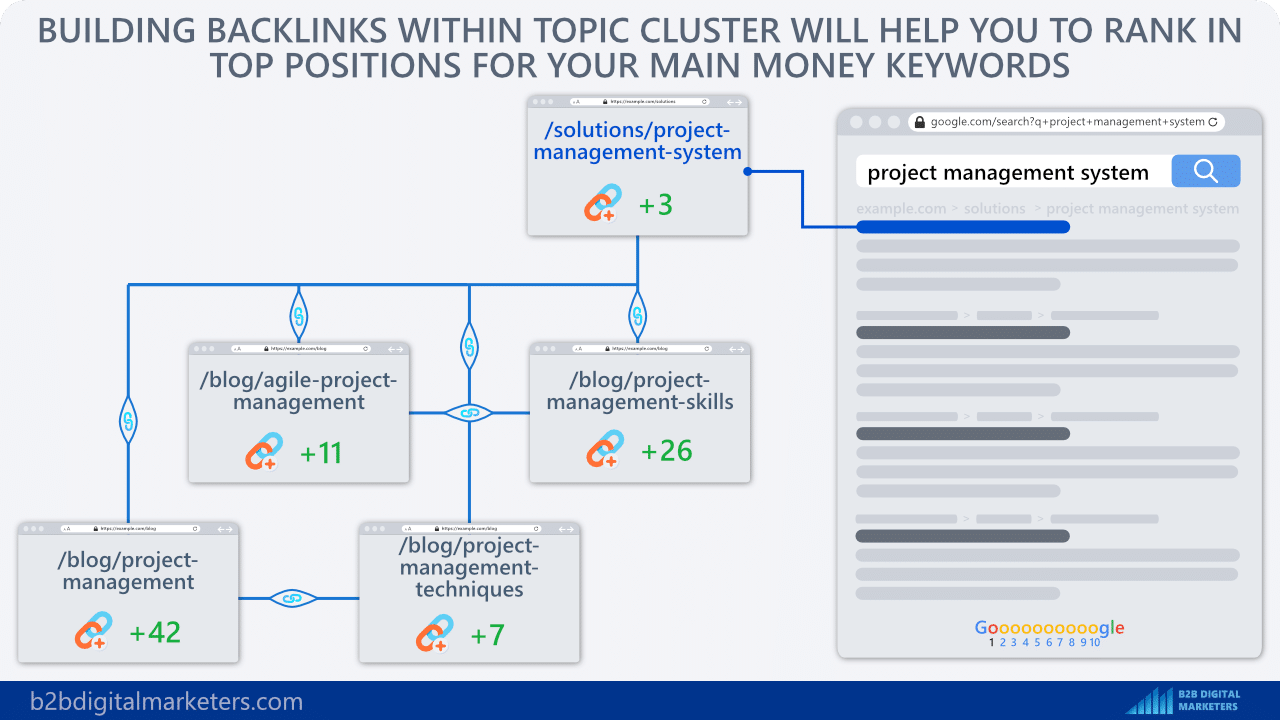
Of course, you can build backlinks to your commercial and transactional keywords, but not that many as you can build backlinks to your informational content.
And once you start building backlinks this way, you start building massive topical authority, and your overall ranking for the topic will increase which means more organic traffic and more leads from your SEO strategy.
However, you will want to balance building backlinks between your topic clusters and low-competition keywords, so you can start generating organic traffic from keywords that have the highest potential to rank in top positions for brand awareness and tiny lead generation.
I recommend building backlinks to low competition keywords ranking in positions 5-20 to get quick and easy wins.

But remember, you’ll need to keep improving the ranking of your main topic cluster and others as well, so you can actually drive leads from your SEO.
This is when you can do 50/50 ratio building backlinks to your topic clusters and low competition keywords or I let you decide how you make your ratio.
However also remember, that your supporting low competition keywords will have internal links coming to your topic cluster as well, so you will still see improvements for your topic cluster informational, commercial and transactional keywords as well.
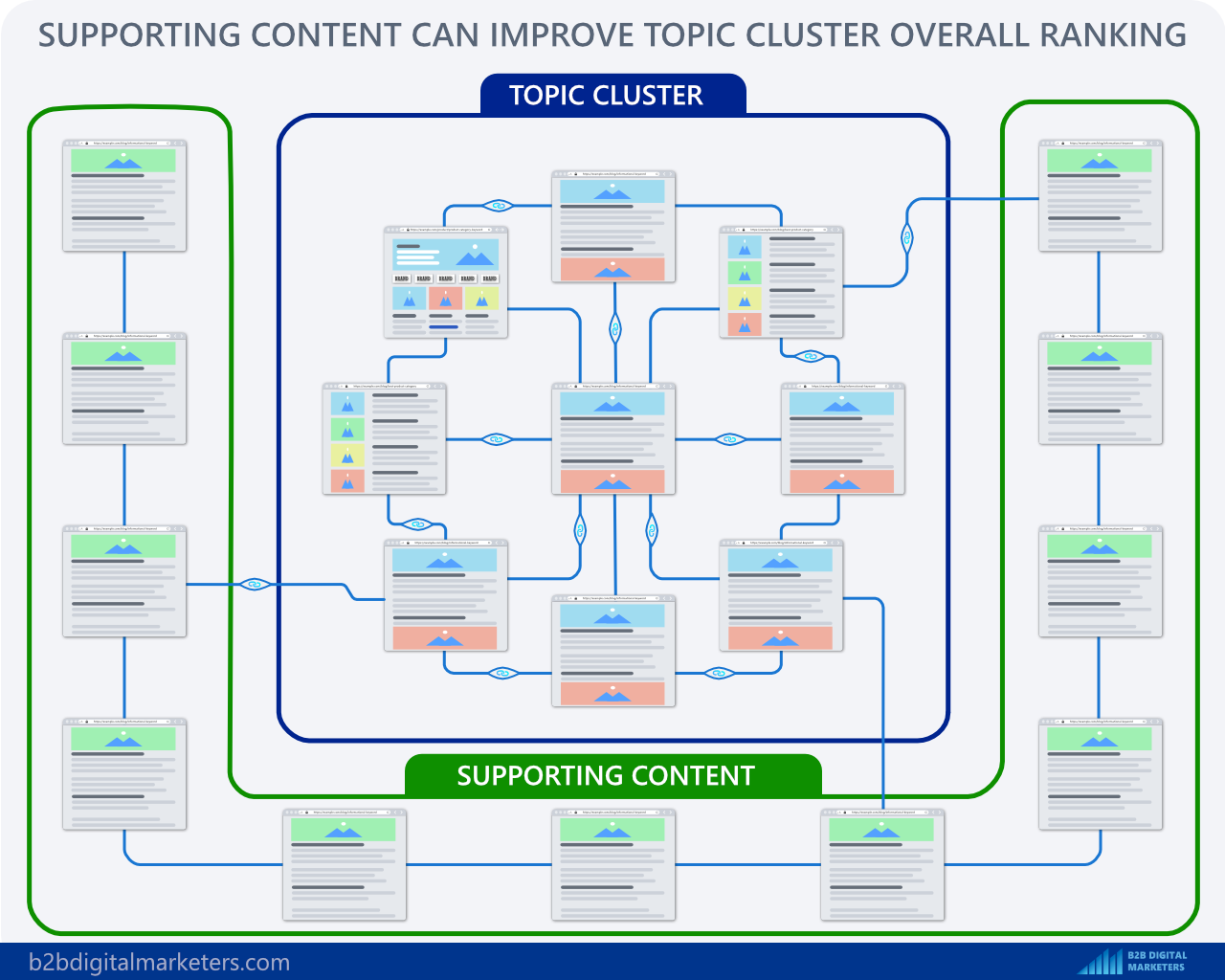
Best Tips to Improve SEO Lead Generation
When it comes to generating SEO leads for your company, driving only organic traffic to your product or service pages is not enough to keep your conversion rate high.
So here I am going to share with you tips to maximize your SEO lead generation potential so you can generate leads from your information content as well as improve your conversion rate from your commercial and transactional content.
1. Create Pop-Ups on Your Website
Definitely, the first and easiest way to boost your lead generation from SEO is to create related popups on your website.
Now, if you are one of the business owners or marketers, that is saying something like “those annoying popups don’t work!” I guess your conversion rate and lead generation are mediocre at best.
According to OptiMonk, the average popup conversion rate is 11.07% on mobile while on the desktop the average conversion rate was 9.69%.
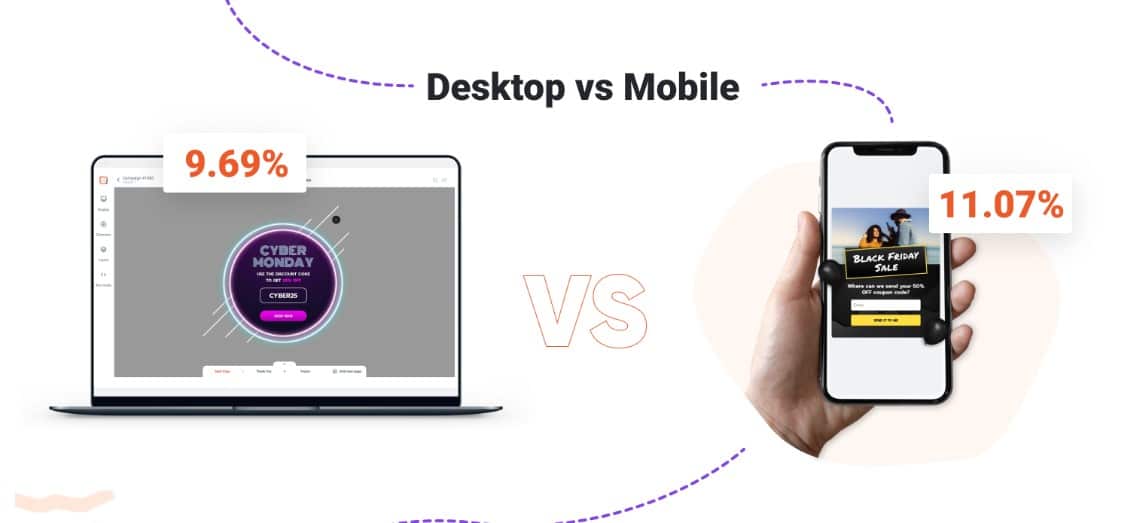
So, if you are not using popups on your website, I promise you, you are missing on leads opportunities and your conversion rate is not doing as well, as it could.
2. Provide Gated Content
Another great way to increase your SEO lead generation is to offer gated content or lead magnets relevant to your subscribers.
Remember, around 97% of users on your website never take any action.

However, with lead magnets/content upgrades/content offers/gated content you can increase that number. Research shows that 50% of marketers who start using lead magnets report higher conversion rates.
Lead magnets are an extremely effective way to capture leads at the TOFU and MOFU stages. These leads are not ready to be marketing qualified leads (MQLs) or sales qualified leads (SQLs) yet but have the potential to become a prospect for your company.
Not only that, but you will rapidly increase your email subscriber list with potential customers.
3. Create Lead Nurturing Sequences
Another great way to increase your lead generation from SEO is by creating a personalized lead nurturing sequence.
If you started using popups and gated content, then you have started generating email subscribers, but not MQLs. With lead nurturing you can turn those email subscribers into MQLs, improve your conversation rate from MQLs to SQLs and even close bigger deals.
In fact, organizations that use marketing automation with prospects experience a 451% increase in qualified leads.
Not only that, but companies that excel at lead nurturing generate 50% more sales-ready leads at a 33% lower cost, and nurtured leads make 47% larger purchases than non-nurtured leads.
So, not only you will be able to get more leads from your SEO by combining popups and gated content with lead nurturing, but also you will improve the quality of leads and the deal size.
4. Promote Your Webinars
Another way to improve your SEO lead generation is to promote your webinars to your website traffic.
Running webinars can be another great way to do lead generation and by promoting your webinars on your blog or across your website you can increase your SEO lead generation and of course get more email subscribers.
According to 73% of B2B marketers said that webinars are the best way to generate high-quality B2B sales leads.
5. Add Phone Number
And the last way to boost your SEO lead generation is to add a sales phone number on your website.
Inbound calls are another key way marketers can drive users to convert. By placing a phone number on your website or offline marketing literature, you can drive users to call you directly.
While 50% of marketers use phone calls to drive leads, Ruler Analytics found that 62% of those struggled to track them.
As said by the Gartner report,
Customers are largely channel-agnostic when seeking the information, they need to get a job done.
As a result, sales reps are not the only channel to customers, but simply a channel, and alignment across in-person and digital channels is crucial for supporting customers in the way they actually buy.
With that, from my experience, I still see some of the potential customers prefer to directly call sales for their answers, and those leads that called salesperson to have a higher conversion rate from MQLs to SQLs.
However, it can be a hustle to track it, especially if your sales do not properly work with your CRM software.
Regardless, you should add your sales number on your website as it is another way to improve your lead generation from SEO.
Final Advice
If you do this right and rank for your most important keywords, you will be able to generate SEO leads day and night and you don’t have to buy SEO leads anymore.
However as said, while the idea of SEO lead generation might seem simple, getting your money pages to rank at the top of the SERPs is another challenge.
I hope you have learned something new. Did you like something particular? Did I forget something? Let me know on my YouTube channel what’s your thoughts.
Related Articles:
- Resource Link Building: Complete Guide You Need
- How to Generate Sales Leads without Cold Calling
- Blogger Outreach: The Right and Not Spammy Way
- B2B Blogging: Best Practices, Tips and Tricks
- B2B Blog Strategy: 9 Step Process Generate Success for Your Company
- SEO for Landscaping: Ultimate & Easy Guide for Non-SEOs
- Is Email Marketing Dead in 2023?
- How to Add Keywords in WordPress? [Guide for Beginners]
Also, check out our SEO hub page to find all our SEO resources.
Disclaimer
Some of my links are affiliate links, which means if you purchase something, I might get a small commission as a reward for reference. Of course, I am actively using all these services and products, and I only affiliate products or services I have full trust in their quality!
Support the B2BDigitalMarketers
Hey, Eduard here.
As a solo blogger with limited resources, I need your support to keep creating in-depth SEO content like this. Please consider joining my Patreon community to help this site grow.
Your pledge – no matter how small – will enable me to dedicate more time to sharing actionable tips and strategies. With your help, I can take this project to the next level and really make a difference for other SEOs and marketers.
I would sincerely appreciate you joining me on this journey as a founding patron. Together, we can build an amazing resource hub. Hope to see you on the inside – thanks for your trust and support!








